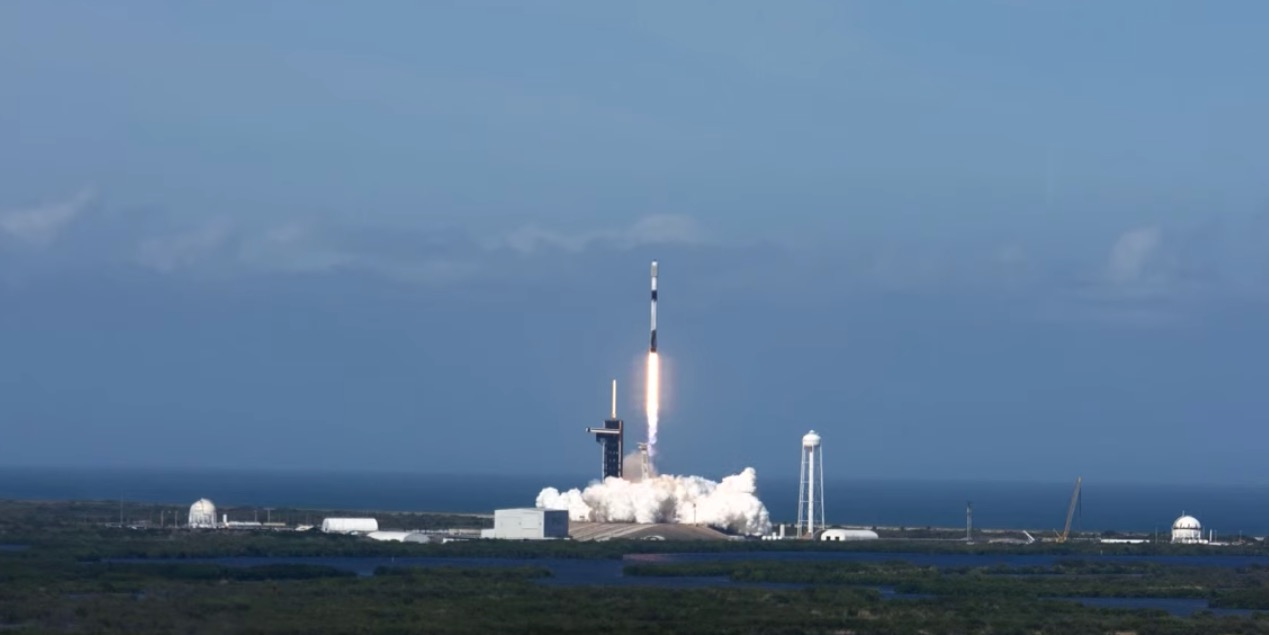SpaceX launches 49 Starlink satellites, lands rocket on droneship at sea
The newly launched satellites will join more than 1,800 functional Starlinks in orbit.
SpaceX just added another 49 satellites to its growing Starlink internet megaconstellation.
A Falcon 9 rocket launched 49 new Starlink satellites to orbit today (Feb. 3), lifting off from NASA's Kennedy Space Center (KSC) on the east coast of Florida at 1:13 p.m. EST (1813 GMT).
About nine minutes after launch, the Falcon 9 rocket's first stage touched down safely on the SpaceX droneship "A Shortfall of Gravitas," which was stationed in the Atlantic Ocean a few hundred miles east of KSC. It was the sixth landing for this particular booster, whose previous launches included the Crew-1 and Crew-2 astronaut-carrying missions to the International Space Station for NASA.
The Falcon 9's upper stage continued carrying the Starlinks to low Earth orbit, where they were deployed as planned 15 minutes and 30 seconds after liftoff. The upper stage was out of range of ground communications at that moment, however, so confirmation of deployment success didn't come until 90 minutes after launch, via a SpaceX tweet.
Related: SpaceX's Starlink satellite megaconstellation launches in photos

This new set of Starlinks, known as Group 4-7, will join more than 1,800 functional satellites in the constellation, according to statistics compiled by Jonathan McDowell, an astrophysicist at the Harvard-Smithsonian Center for Astrophysics who also assiduously tracks satellites and space debris.
This was the third Starlink launch of 2022 already, following two that the company performed in January. SpaceX appears therefore to be moving swiftly to build out its constellation and expand it further into rural areas to improve internet service.
Breaking space news, the latest updates on rocket launches, skywatching events and more!
What's more, SpaceX founder and CEO Elon Musk promised on Twitter last month that laser links would be "active soon" on the constellation. The inter-satellite optical laser links are meant to improve the rate of transmitting data in the constellation to further boost speeds to Starlink's customer base.
SpaceX eventually hopes to have as many as 42,000 satellites in the Starlink megaconstellation, although that goal is not without criticism.
For example, a new review of observations by the Zwicky Transient Facility (ZTF) in Southern California, which is designed to hunt for supernova explosions as well as asteroids passing relatively close to Earth, showed that twilight observations have been affected more and more by Starlink satellites.
The ratio of affected twilight images was only 0.5% in late 2019 but soared to 20% in late 2021 as the number of Starlinks aloft increased, the authors said in their study. Moreover, interference with images is expected to increase, especially as megaconstellations from OneWeb, Amazon, China's SatNet and other organizations grow.

A separate study in 2021 suggested that Starlink satellites are involved in about 1,600 close encounters between spacecraft every week, representing 50% of near-collisions in orbit, according to Hugh Lewis, the head of the Astronautics Research Group at the United Kingdom's University of Southampton. (A near-collision is defined as when two spacecraft pass within a distance of 0.6 miles, or 1 kilometer, from each other.)
That said, SpaceX has repeatedly stressed that it is committed to working with the space community to dim its satellites and has said that astronomical observations should not be unduly affected by its individual satellites.
The launch of Group 4-7 was originally targeted for last week but was delayed multiple times due to weather interfering with the planned launch of another SpaceX mission, which ended up lofting the Italian CSG-2 Earth-observation satellite on Monday (Jan. 31) from Cape Canaveral Space Force Station, which is next door to KSC.
The CSG-2 launch kicked off a busy week for SpaceX, which also launched the NROL-87 spy satellite for the U.S. National Reconnaissance Office on Wednesday (Feb. 2) from California's Vandenberg Space Force Base.
The Falcon 9's first stage wasn't the only piece of reused hardware on today's Starlink launch. The mission also marked the sixth flight for one half of the Falcon 9's payload fairing — the protective "nose cone" that surrounds satellites during launch — and the fourth for the other half. SpaceX aims to recover the fairings from the ocean for even further reuse, SpaceX quality engineer Andy Tran said during the webcast of today's launch.
Editor's note: This story was updated at 3 p.m. EST on Feb. 3 with news of successful satellite deployment.
Follow Elizabeth Howell on Twitter @howellspace. Follow us on Twitter @Spacedotcom and on Facebook.

Elizabeth Howell (she/her), Ph.D., was a staff writer in the spaceflight channel between 2022 and 2024 specializing in Canadian space news. She was contributing writer for Space.com for 10 years from 2012 to 2024. Elizabeth's reporting includes multiple exclusives with the White House, leading world coverage about a lost-and-found space tomato on the International Space Station, witnessing five human spaceflight launches on two continents, flying parabolic, working inside a spacesuit, and participating in a simulated Mars mission. Her latest book, "Why Am I Taller?" (ECW Press, 2022) is co-written with astronaut Dave Williams.
